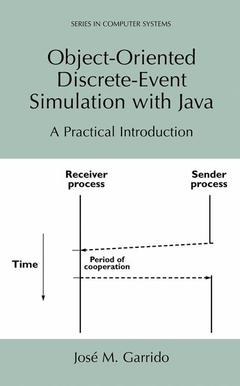Description
Object-Oriented Discrete-Event Simulation with Java, Softcover reprint of the original 1st ed. 2001
A Practical Introduction
Series in Computer Science Series
Author: Garrido José M.
Language: English
Subject for Object-Oriented Discrete-Event Simulation with Java:
Keywords
C++; Java; Simula; Unified Modeling Language (UML); class; model; modeling; simulation
Approximative price 158.24 €
In Print (Delivery period: 15 days).
Add to cart
Object-Oriented Discrete-Event Simulation with Java
Publication date: 04-2013
256 p. · 15.5x23.5 cm · Paperback
Publication date: 04-2013
256 p. · 15.5x23.5 cm · Paperback
Approximative price 229.00 €
Subject to availability at the publisher.
Add to cart
Object-oriented discrete-event simulation with java
Publication date: 10-2001
272 p. · Paperback
Publication date: 10-2001
272 p. · Paperback
Description
/li>Contents
/li>
Researches and developers of simulation models state that the Java program ming language presents a unique and significant opportunity for important changes in the way we develop simulation models today. The most important characteristics of the Java language that are advantageous for simulation are its multi-threading capabilities, its facilities for executing programs across the Web, and its graphics facilities. It is feasible to develop compatible and reusable simulation components that will facilitate the construction of newer and more complex models. This is possible with Java development environments. Another important trend that begun very recently is web-based simulation, i.e., and the execution of simulation models using Internet browser software. This book introduces the application of the Java programming language in discrete-event simulation. In addition, the fundamental concepts and prac tical simulation techniques for modeling different types of systems to study their general behavior and their performance are introduced. The approaches applied are the process interaction approach to discrete-event simulation and object-oriented modeling. Java is used as the implementation language and UML as the modeling language. The first offers several advantages compared to C++, the most important being: thread handling, graphical user interfaces (QUI) and Web computing. The second language, UML (Unified Modeling Language) is the standard notation used today for modeling systems as a collection of classes, class relationships, objects, and object behavior.
1. Introduction to Simulation. 2. Objects, Classes and UML. 3. Relevant Aspects of the Java. 4. Discrete-Event Simulation. 5. Simulation with the Process Worldview. 6. Models of Multi-Server Systems. 7. Multi-Class Queuing Models. 8. Resources. 9. Basic Process Cooperation. 10. Synchronous Cooperation. 11. Conditional Waiting. 12. Interrupts. 13. More Simulation Models. 14. Basic Probability Theory and Random Numbers. 15. Overview of Model. Appendix A. Appendix B. About the Author. Index.
© 2024 LAVOISIER S.A.S.




